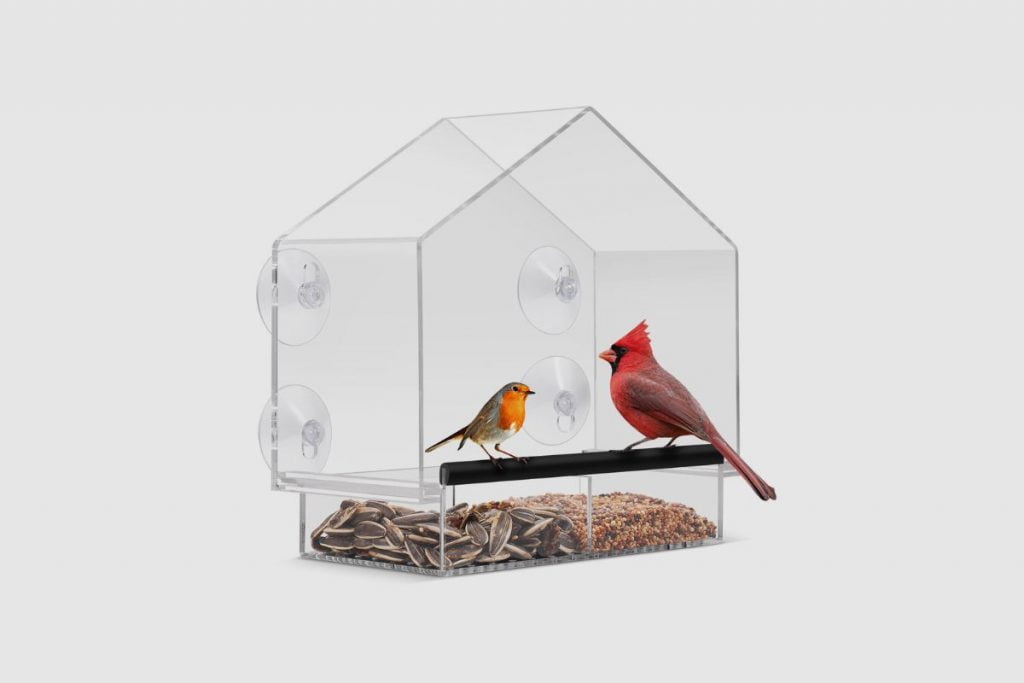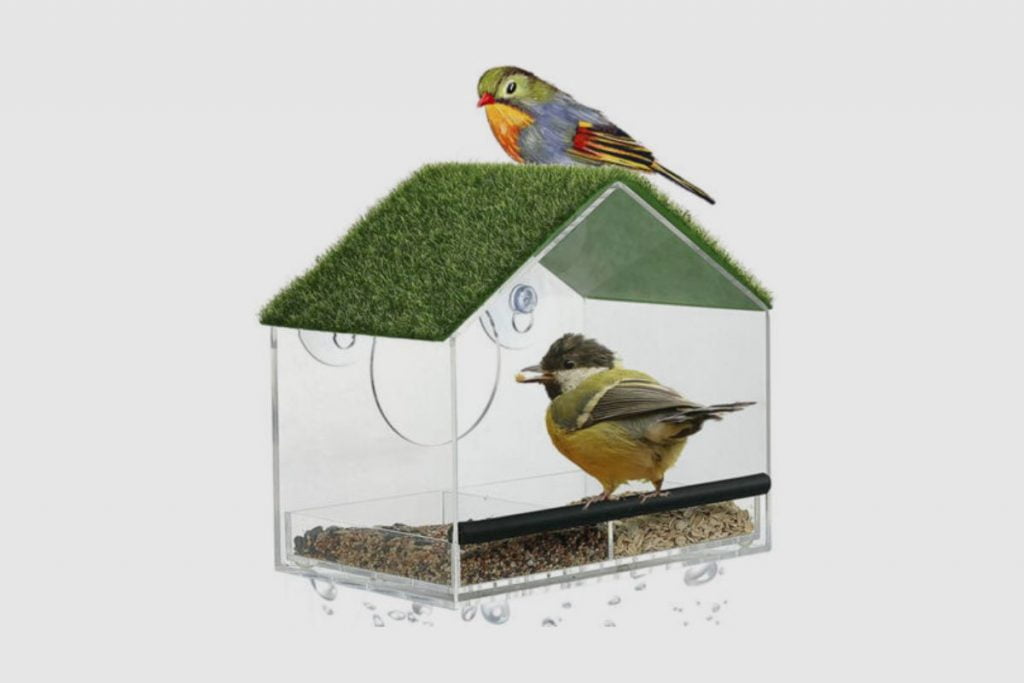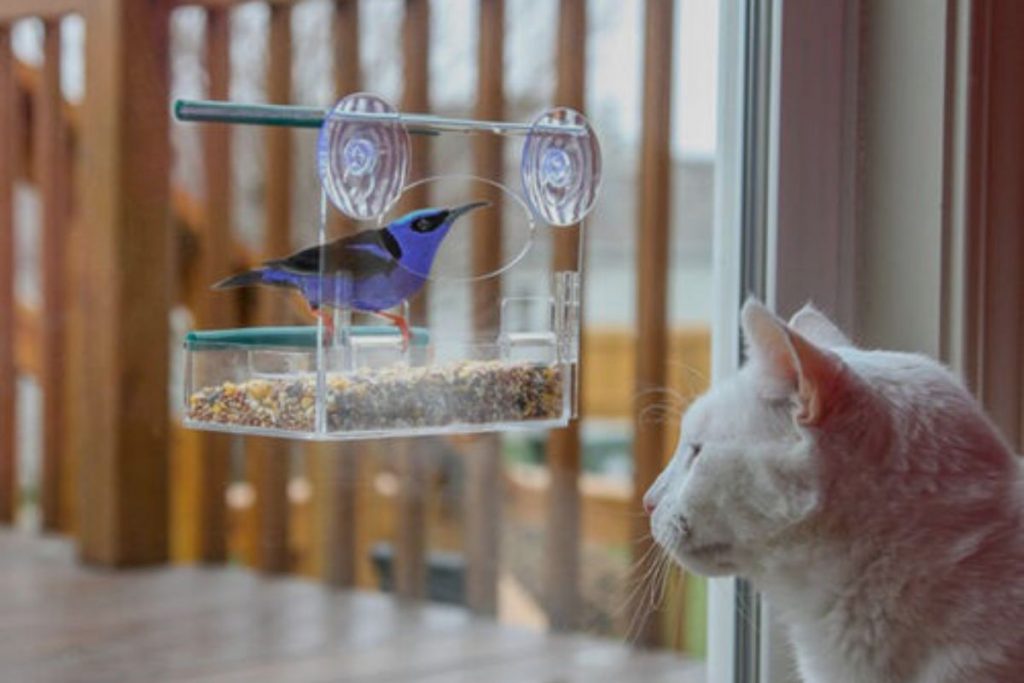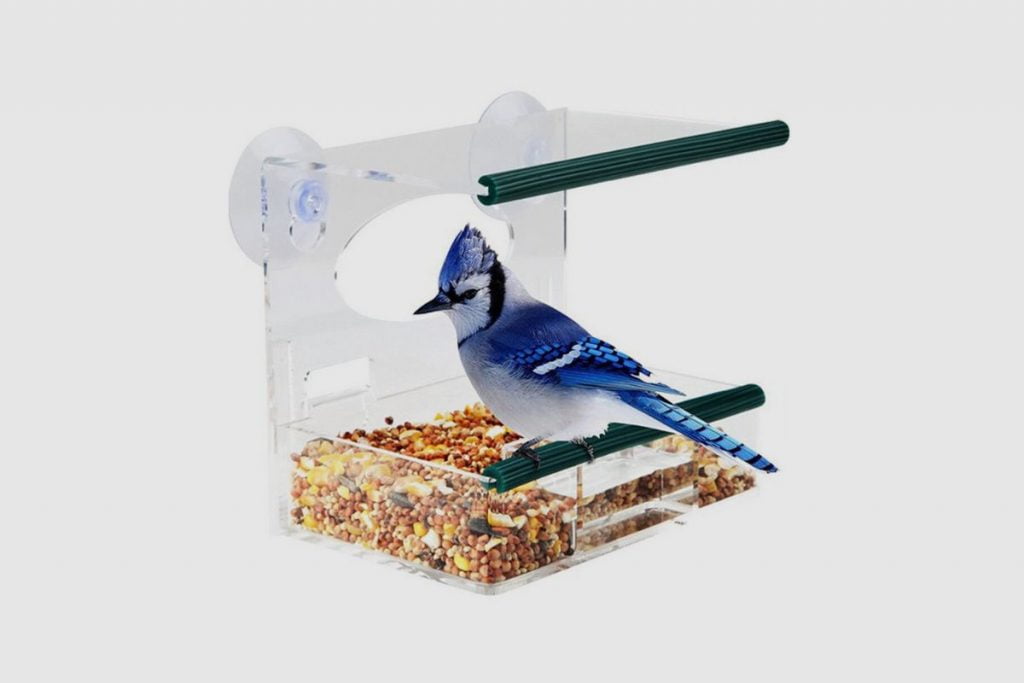Window bird feeders are not inherently bad, but they do come with some potential issues. The main concern is the risk of bird collisions with the window, which may lead to injuries or fatalities. Also, these bird feeders might attract rodents or other pests, creating problems for homeowners.
There’s also the possibility of disease transmission between birds and humans through the feeders.
To mitigate these risks while still enjoying the benefits of a window bird feeder, consider the following precautions:
- Position the feeder thoughtfully: Place it either very close (within 3 feet) or at least 10-15 feet away from the window to reduce the chances of bird collisions.
- Keep the area clean: Regularly clean the feeder and surrounding area to prevent the spread of diseases and discourage pests.
- Use anti-collision decals or window films: Apply these products to your windows to help birds recognize the barrier and avoid collisions.
- Select the right feed: Provide high-quality bird feed to attract desired bird species and minimize the potential for disease transmission.
- Monitor the feeder: Keep an eye on the feeder for any signs of disease or pest infestations and take action accordingly.
By taking these measures, you can enjoy the benefits of a window bird feeder while minimizing the potential drawbacks.

Benefits of Window Bird Feeders
As someone who loves watching birds, you’ll be pleased to know that window bird feeders offer numerous benefits. By installing one at your home, you can experience the following advantages:
- Close-up observation: Window bird feeders allow you to observe birds up close, providing an intimate and detailed view of their behaviour, plumage, and feeding habits. This can be both educational and enjoyable, fostering a deeper appreciation for nature and wildlife.
- Stress relief: Watching birds at your window feeder can help reduce stress and anxiety. Many people find it therapeutic and calming to observe these creatures as they go about their daily lives, offering a moment of respite from the hustle and bustle of everyday life.
- Support local bird populations: By providing a reliable food source, you’re directly supporting local bird populations, particularly during harsh weather conditions or when natural food sources may be scarce. This can contribute to the overall health and well-being of the birds in your area.
- Educational opportunities: Window bird feeders can serve as excellent educational tools for children and adults alike. They help teach about different bird species, their behaviours, and their roles in the local ecosystem. This can foster a love for nature and encourage responsible environmental stewardship.
- Attract a variety of bird species: With a window bird feeder, you can attract a diverse range of bird species to your home, depending on the type of feed you provide. This can be particularly rewarding for birdwatchers and nature enthusiasts who enjoy observing and identifying different species.
- Eco-friendly entertainment: A window bird feeder offers an eco-friendly and sustainable form of entertainment. Unlike some other hobbies, birdwatching has a minimal environmental impact, making it a responsible choice for those who care about preserving nature.
With all these benefits, you can better understand the value of having a window bird feeder. Keep in mind the potential risks, and take necessary precautions to ensure that you can safely enjoy the rewards of this engaging pastime.

Possible Hazards for Birds Associated with Window Bird Feeders.
As a bird enthusiast, it’s essential to be aware of the possible hazards associated with window bird feeders. By understanding these risks, you can take steps to minimize their impact and create a safer environment for the birds that visit your feeder. Some potential hazards include:
- Window collisions: One of the main concerns with window bird feeders is the risk of birds colliding with the window while attempting to access the feeder. These collisions can result in injuries or even fatalities for the birds. To mitigate this risk, consider positioning your feeder either very close to the window or further away to give the birds more room to manoeuvre.
- Disease transmission: If not cleaned regularly, window bird feeders can become breeding grounds for bacteria and parasites, leading to the spread of diseases among the visiting bird populations. To minimize this risk, ensure that you clean and sanitize your feeder frequently and remove any spoiled or wet food.
- Attraction of pests: Window bird feeders may inadvertently attract rodents or other pests due to spills or excess bird feed. These pests can not only create a nuisance for you but also pose a risk to the birds by spreading diseases or competing for food resources. To address this issue, make sure to clean up any spilt food and avoid overfeeding the birds.
- Predators: Window bird feeders may expose birds to potential predators, such as cats, by attracting them to the feeder. To protect the birds, you can position the feeder in a location that is difficult for predators to access and take steps to discourage cats from coming into your yard.
- Human interference: Some birds may become dependent on window feeders as a food source, which could make them more vulnerable to human disturbances or changes in feeding routines. To reduce this risk, try to maintain a consistent feeding schedule and gradually decrease the amount of food provided if you need to stop feeding the birds.
These are just a few of the potential hazards associated with window bird feeders. By being aware of these potential hazards and taking appropriate precautions, you can help ensure that your window bird feeder remains a safe and enjoyable experience for both you and the birds.

Tips for Making Window Bird Feeders Safer for Birds
Aside from some of the safety measures I mentioned earlier, to enhance the safety of window bird feeders for birds, consider the following these tips:
- Provide a variety of foods: Offer different types of seeds or food to cater to the diverse dietary needs of various bird species. This encourages a healthier and more balanced diet, which can ultimately strengthen their immune systems and reduce their vulnerability to diseases.
- Use a squirrel-proof feeder: Invest in a squirrel-proof feeder to prevent squirrels from stealing the bird food and discouraging birds from visiting your feeder. This also helps reduce the risk of attracting other pests and rodents.
- Offer natural perching options: Provide nearby natural perching options, such as branches or shrubs, to give birds a place to rest or escape from predators. This makes the area around your feeder more inviting and safer for the birds.
- Avoid placing feeders near reflective surfaces: Apart from windows, avoid placing your bird feeder near other reflective surfaces, such as mirrors or metallic objects. This can help reduce the risk of bird collisions and confusion.
- Monitor bird activity: Keep a close eye on the birds that visit your feeder, and take note of any changes in their behaviour or health. If you notice any signs of disease or distress, temporarily remove the feeder and seek advice from a local wildlife expert or rehabilitation centre.
By implementing these additional tips, you can create an even safer environment for the birds that visit your window bird feeder, ensuring that both you and the birds can continue to enjoy the many benefits that window bird feeders have to offer.

Final Thought
In conclusion, the question “Are Window Bird Feeders Bad?” ultimately depends on how they are managed and maintained.
While there are potential risks and hazards associated with window bird feeders, many of these can be mitigated by taking appropriate precautions and being mindful of the birds’ well-being.
As a bird lover, it’s important to strike a balance between the enjoyment and educational value of window bird feeders and the responsibility to ensure the safety and health of the birds.
Remember that your actions can make a significant difference in creating a safer environment for these beautiful creatures. If you’re considering installing a window bird feeder or already have one, take the time to implement the safety tips and precautions mentioned above.
By doing so, you can contribute to the well-being of the birds while enjoying the numerous benefits that window bird feeders have to offer.
Have any tips to share? Feel free to leave your comments in the comment section below, and thanks for reading.
Frequently Asked Questions (FAQ)
Q: Are window bird feeders bad for wild birds?
A: Window bird feeders are generally not bad for wild birds. They allow you to easily watch the birds up close while providing them with a reliable source of food. However, precautions should be taken to ensure the feeders do not pose a hazard, such as bird strikes or attracting predators.
Q: How can I keep birds safe from predators when using window feeders?
A: To keep birds safe from predators while using window feeders, position the feeder on windows with suction cups at least 30 feet away from places where free-roaming cats or other predators can hide. Additionally, placing the feeder within three feet of the window can help reduce the chances of bird strikes.
Q: Do window bird feeders cause bird strikes?
A: Windows that reflect the sky or trees can cause bird strikes. To prevent this, use decals on the windows to make them less reflective and ensure the window feeder is placed either within three feet or more than 30 feet away from the window to minimize the risk of injury to your feathered friends.
Q: What types of birds can I expect to see if I use a window feeder?
A: A variety of birds come to window feeders, including species like the goldfinch, hummingbird, sparrow, cardinal, robin, nuthatch, and wren. The type of birdseed and feeder can influence which birds visit your backyard.
Q: How do I maintain my window bird feeder?
A: To maintain your window bird feeder, clean it every two weeks to prevent moldy or spoiled birdseed. Use a mild soap and water solution, and rinse thoroughly. If you have a hummingbird feeder, clean it and replace the nectar regularly to keep birds healthy.
Q: What is the best way to deter larger birds from monopolizing a window feeder?
A: If larger birds, such as woodpeckers or jays, monopolize the feeder, consider using a platform feeder with a design that restricts their access while allowing smaller birds to feed. Also, offering different types of bird food can help attract a variety of species.
Q: Can I use a window bird feeder year-round?
A: Yes, you can use a window bird feeder year-round. Offering different types of birdseed and nectar depending on the season can help attract a variety of birds. Supplemental feeding is especially helpful during migration and when natural food sources are scarce.
Q: How close to my window should I put bird feeders?
A: For safety, place the window feeder within three feet or more than 30 feet from a window. This placement reduces the risk of bird strikes and allows you to watch the birds without them getting injured by the pane of glass.
Q: What should I do if birds don’t come to my window feeder?
A: If birds don’t come to your window feeder, try changing the location, offering different types of birdseed, or adding native plants around your backyard to create a more attractive habitat. Being patient and making small adjustments can help encourage birds to visit.
